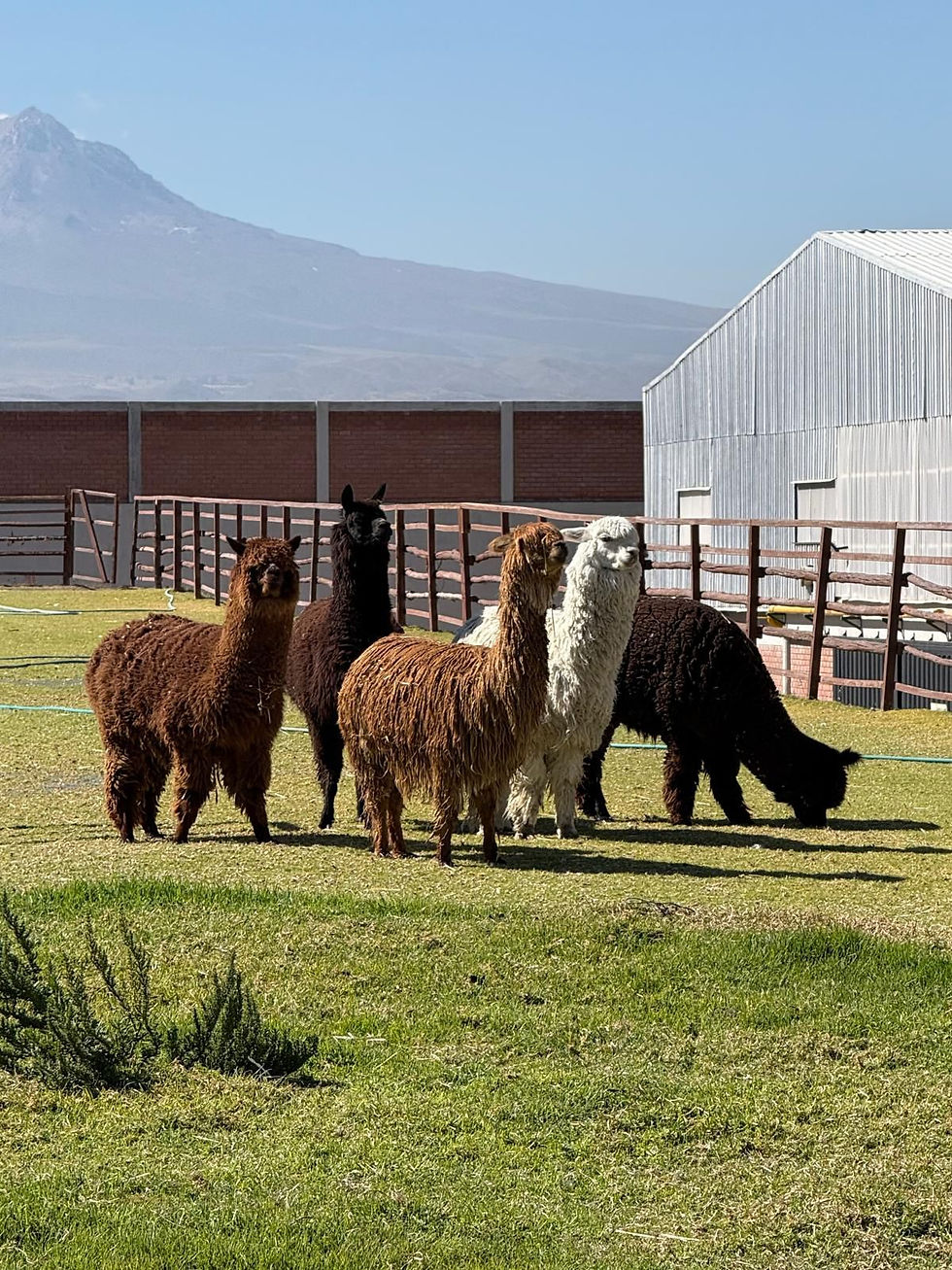Perù: dove tradizione e innovazione si intrecciano nella fibra d’alpaca
- biellamaster
- 9 ott
- Tempo di lettura: 7 min
Dopo le prime esperienze oltreoceano tra Messico e Stati Uniti, i masterini hanno proseguito il loro viaggio intercontinentale verso una nuova e affascinante destinazione: il Perù, patria indiscussa della fibra di alpaca. Se nei primi giorni all’estero l’attenzione si era concentrata sul mondo del retail e sulle dinamiche di relazione con il cliente in contesti culturali differenti, questa seconda tappa ha riportato gli studenti alle radici stesse della filiera, laddove la materia prima prende forma e inizia il suo percorso verso i mercati internazionali.
Il Perù, con le sue Ande maestose e i suoi paesaggi senza tempo, ha accolto i masterini con un’atmosfera sospesa tra tradizione e modernità. Qui hanno avuto l’opportunità di osservare da vicino i processi produttivi che caratterizzano l’universo dell’alpaca, scoprendo non solo le tecniche industriali che danno vita ai filati, ma anche la dimensione culturale e sociale che questa fibra rappresenta per l’intero Paese. Il viaggio, durato quattro giorni intensi, si è rivelato un’immersione completa in un ecosistema che unisce allevatori, aziende, ricercatori e comunità locali, tutti accomunati dalla stessa missione: valorizzare e proteggere una delle fibre nobili più pregiate al mondo.

Il primo giorno ha avuto come protagonista Incatops, una delle realtà cardine del settore. I masterini hanno iniziato dalla Plant 4 dell’azienda, dove hanno assistito al momento in cui il vello grezzo arriva per essere smistato manualmente e successivamente lavato e pettinato. È impressionante osservare la rapidità e la sicurezza con cui gli operatori dividono le fibre in base a colore e finezza riconoscendo immediatamente le parti più grossolane da quelle più pregiate, come le spalle. Questa fibra, che rappresenta il primo pelo dell’animale, è particolarmente ricercata per la sua morbidezza e rarità, destinata a diminuire con la crescita. Quel lavoro, ripetuto con gesti precisi e antichi, ha trasmesso ai masterini il messaggio che dietro ogni filato non ci sono solo macchinari, ma anche competenze che si tramandano nel tempo. Successivamente hanno visitato la Plant 2, dedicata alla ripettinatura e filatura. Qui i masterini hanno trovato un ambiente completamente diverso: macchinari all’avanguardia, processi industriali moderni e una tecnologia a livello delle filature italiane. È stato un contrasto affascinante: dalla manualità attenta e lenta del primo reparto a una filatura veloce, precisa, automatizzata. Il pomeriggio è stato dedicato agli uffici stile e commerciali, dove i masterini hanno potuto vedere e toccare i filati finiti, discutere con i responsabili aziendali e comprendere meglio come una fibra così tradizionale possa essere comunicata al mondo con strumenti di marketing moderni. Qui hanno capito che non basta avere un prodotto eccellente: serve anche saperlo raccontare.
Il secondo giorno è stato dedicato a Incalpaca, l’azienda gemella di Incatops. I masterini si sono ritrovati in un ambiente dove il filato prende forma e diventa tessuto, capo, collezione. Muoversi tra i reparti significava attraversare mondi diversi: la tintoria, dove i colori sembravano amplificarsi; la tessitura, con telai sia a licci che jacquard; la sartoria industriale, ordinata e precisa, con abili mani al lavoro; l’ufficio modelli e la stamperia digitale, veri laboratori di creatività. Qui i masterini hanno scoperto due anime ben distinte: la linea Alpaca 111, giovane, sportiva, pensata per un pubblico ampio e Kuna, la collezione di punta, con capi di altissima qualità, alcuni realizzati persino in vicuña, la fibra più rara e preziosa del mondo andino. Osservare questi capi da vicino ha trasmesso ai masterini la sensazione di avere tra le mani non solo prodotti di moda, ma vere e proprie opere d’arte tessile. La visita si è conclusa con un incontro con il responsabile marketing, che ha illustrato la mission dell’azienda: promuovere le fibre di alpaca e vicuña e consolidarne la reputazione a livello globale. Per i masterini è stato un momento di dialogo stimolante, che ha fatto emergere quanto la strategia e la visione d’impresa siano fondamentali per rendere competitivo un prodotto tradizionale anche sui mercati più esigenti.

Gli ultimi due giorni i masterini li hanno trascorsi a Pacomarca, la fattoria modello che rappresenta il cuore dell’ecosistema alpaca. L’arrivo in questo luogo ha avuto un impatto forte offrendo un paesaggio che ha trasmesso pace e allo stesso tempo la grandezza del lavoro che vi si svolge. Pacomarca non è solo un allevamento, ma anche un centro di ricerca e innovazione. I masterini hanno incontrato ricercatori che, con passione, hanno raccontato come studiano la fibra per migliorarne la qualità, affrontando sfide come la difficile tingibilità o la selezione delle fibre più pregiate. È stato chiaro fin da subito che qui scienza e tradizione convivono armoniosamente. La fattoria porta avanti anche progetti sociali importanti: ogni nuova scoperta viene condivisa con tutti gli allevatori del Perù, creando una rete che valorizza il lavoro di migliaia di persone. I masterini hanno colto in questo gesto il vero spirito del Paese: unito, fiero e determinato a crescere insieme. Tra i progetti che più hanno colpito i masterini c’è stato quello sul reinserimento dell’alpaca nero. Una fibra naturalmente scura, unica, che non richiede tintura e che quindi rappresenta anche una scelta sostenibile. Una storia di innovazione che guarda al futuro senza dimenticare le radici.
Al termine dei quattro giorni, i masterini hanno compreso che la filiera dell’alpaca non è solo un insieme di passaggi produttivi, ma un racconto fatto di mani esperte, paesaggi andini, ricerca scientifica e scelte strategiche. Ogni fase – dallo smistamento manuale della fibra grezza alla creazione di un capo di alta moda – è il risultato di un equilibrio perfetto tra tradizione e innovazione. Il Perù ha mostrato loro non soltanto la preziosità della fibra, ma anche la forza di un popolo che lavora insieme per portare nel mondo un prodotto simbolo della propria identità. I masterini sono tornati con un bagaglio arricchito non solo di conoscenze professionali, ma anche di emozioni, immagini e sensazioni che resteranno a lungo nella memoria: la leggerezza della baby alpaca, il silenzio maestoso delle Ande, i sorrisi orgogliosi di chi lavora con passione per custodire un patrimonio che appartiene a tutti.
After their first experiences overseas between Mexico and the United States, the masterini continued their intercontinental journey toward a new and fascinating destination: Peru, the undisputed homeland of alpaca fiber. While the first weeks abroad focused on retail and customer relations across different cultural contexts, this second stop brought the students back to the very roots of the supply chain, to the places where raw materials take shape and begin their journey to international markets. Peru, with its majestic Andes and timeless landscapes, welcomed the masterini with an atmosphere suspended between tradition and modernity. Here, they had the opportunity to observe the production processes that define the world of alpaca up close, discovering not only the industrial techniques that give life to the yarns but also the cultural and social dimensions that this fiber represents for the entire country. The four intense days of travel culminated in a full immersion in an ecosystem that unites breeders, companies, researchers, and local communities, all driven by the same mission: to enhance and protect one of the world’s most precious and noble fibers.

The first day was dedicated to Incatops, one of the key players in the industry. The masterini began at the company’s Plant 4, where they witnessed the moment when raw fleece arrives to be manually sorted, then washed and combed. It was impressive to watch the speed and confidence with which operators separate the fibers by color and fineness, instantly recognizing the coarser parts from the most valuable ones, such as the shoulders. This fiber, representing the animal’s first fleece, is especially prized for its softness and rarity, qualities that gradually diminish as the animal grows. That repetitive, precise, and almost ancestral gesture conveyed an essential message: behind every yarn there are not only machines, but also skills and know-how passed down through generations. Later, they visited Plant 2, dedicated to re-combing and spinning. Here, the masterini encountered a completely different environment: cutting-edge machinery, modern industrial processes, and technology on par with the finest Italian spinning mills. It was a fascinating contrast, from the slow, careful manual work of the first department to a fast, precise, and automated spinning line. In the afternoon, attention shifted to the style and commercial offices, where the masterini could see and touch finished yarns, engage with company managers, and better understand how such a traditional product can be communicated worldwide through modern marketing tools. They realized that having an excellent product is not enough; you must also know how to tell its story.
The second day was dedicated to Incalpaca, Incatops’ sister company. Here, the masterini found themselves in a setting where yarn becomes fabric, garment, and collection. Walking through the various departments meant moving across different worlds: the dyeing rooms, where colors seemed to come alive; the weaving area, with both dobby and jacquard looms; the industrial tailoring section, neat and precise, with skilled hands at work; and finally, the pattern and digital printing offices, true laboratories of creativity. The masterini discovered two distinct identities: Alpaca 111, a young, sporty line designed for a wide audience, and Kuna, the company’s high-end collection featuring garments of the utmost quality, some even made with vicuña, the rarest and most valuable fiber in the Andes. Observing these garments up close gave the students the feeling of holding not just fashion pieces, but genuine textile artworks. The visit concluded with a meeting with the marketing manager, who presented the company’s mission: to promote alpaca and vicuña fibers and strengthen their global reputation. It was a stimulating discussion that highlighted how strategy and vision are key to making a traditional product competitive even in the most demanding international markets.

The final two days were spent at Pacomarca, the model farm that represents the beating heart of the alpaca world. Arriving there had a profound impact: a landscape that conveyed peace and, at the same time, the magnitude of the work carried out within it. Pacomarca is not only a farm but also a center for research and innovation. The masterini met researchers who passionately explained how they study the fiber to improve its quality, addressing challenges such as dyeability and the selection of the finest fibers. It was immediately clear that here, science and tradition coexist in perfect harmony. The farm also leads important social projects: every discovery is shared with alpaca breeders across Peru, creating a network that empowers thousands of people. The masterini recognized in this practice the true spirit of the country: united, proud, and determined to grow together. Among the projects that most impressed them was the one focused on reintroducing black alpaca, a naturally dark, unique fiber that requires no dyeing and thus represents a sustainable choice. It’s a story of innovation that looks to the future while staying rooted in tradition.
By the end of the four days, the masterini had come to understand that the alpaca supply chain is far more than a sequence of production steps. It is a story woven from skilled hands, Andean landscapes, scientific research, and strategic choices. Every stage — from the manual sorting of raw fleece to the creation of a high-fashion garment — reflects a perfect balance between heritage and innovation. Peru revealed to them not only the exceptional value of the fiber itself, but also the strength of a country working together to bring to the world a product that embodies their identity. The masterini returned home enriched not only with professional knowledge, but also with emotions, images, and sensations that will stay with them for a long time: the lightness of baby alpaca, the majestic silence of the Andes, and the proud smiles of those who work passionately to preserve a heritage that belongs to everyone.








Commenti